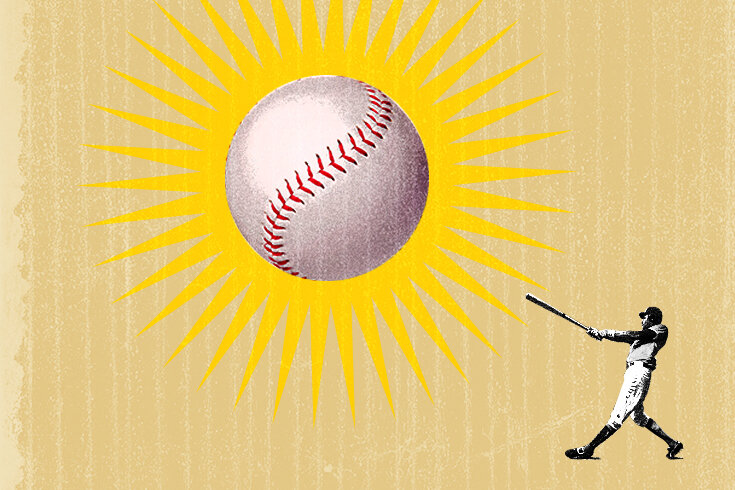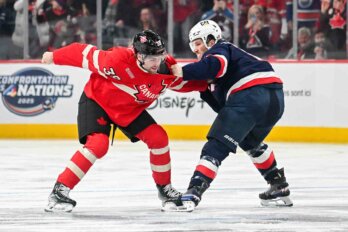The summer of 1998 was when baseball was captivated by moonshots and the chase for Roger Maris’s single-season record of sixty-one homers. Bunyanesque St. Louis Cardinals first baseman Mark McGwire and Chicago Cubs outfielder Sammy Sosa raced to see who would be the first to best Maris’s mark. McGwire, large and solid as an oak, had four home runs through his first four games and was off to the races. Sosa—whippet lean when he debuted with the Rangers, in 1989, before being flipped to the White Sox the same year, then dealt to the Cubs, and by ’98 equally as brawny as McGwire—got off to a slow start but closed the gap by clearing the fence twenty times in the month of June. By mid-August, the sluggers were tied at forty-seven, and media coverage went from heated to breathless. McGwire eventually won the race, hitting his sixty-second on September 8 and finishing the campaign with seventy. Sosa stalled near the finish line and wound up with sixty-six—thirty more home runs than he’d hit the previous season.
In American Pastoral, Philip Roth identified a homegrown varietal of hysteria he deemed the “American berserk,” and the contemporary dialogue surrounding the home run seems to speak to that anxiety—America’s gobbling ambition, its voraciousness, the muscly sense that to grind a ball into dust is a better and more exclamatory statement than a run scored piecemeal, through guile, sacrifice, and base hits.
It’s always been there, of course, or at least since Babe Ruth’s home run revolution. Yankees teammates Maris and Mickey Mantle followed in Ruth’s footsteps in the 1960s, and in the ’70s, Orioles manager Earl Weaver preached the value of “pitching, defence, and the three-run home run.”
In the anti-intellectual atmosphere of post-9/11 America, though, the swift and brutal rip through the strike zone seemed more appropriate than ever. Swinging for the fences became a primary characteristic of the game, a trend that continues today and that doesn’t figure to go away. The homer has become too revered, taken on too big a profile, assumed too great an importance in the game as it’s played now, to allow us to step wholly back. If the age of shock and awe deserved Barry Bonds, our even more dire-seeming age is perhaps best exemplified by Yankees slugger Aaron Judge, a human built on a different scale than you and I, with a swing that leaves no space for nuance.
This is all to say that sacrifice bunts don’t attract contemporary viewers. They lack the inherent violence of the home run, the assertion of power, the unmistakable muscle. A base hit is accretive and team oriented; it suggests faith in the hitters behind you. The home run is individual and ego focused, one player’s blood, bone, and sinew held aloft to deafening cheers.
At this point, arguing against the home run is pointless. The results are in and brawn has won—both in the ratings and on the field—and now, squarely within the launch-angle era, the essential violence of the act hints that baseball’s ostensible pastorality was misquoted, or ill understood, or more darkly still, a craven dishonesty.
A study in 2018 found that the balls put into use three years earlier, while not juiced, per se, were mysteriously more aerodynamic than they used to be, resulting in yet another spike in home runs: 6,105 were hit in 2017, more than in any previous season. That record, in turn, was pushed aside in 2019, when 6,776 homers were recorded. Also in 2019, when both Triple-A leagues switched from their own unique Chinese-manufactured balls to the very same Costa Rican–made balls used in Major League Baseball, home run totals across both leagues jumped 57 percent.
But it’s not just what you hit, it’s where you do the hitting. When Safeco Field opened, in 1999, it had one of the most spacious outfields in baseball, with the centre-field fence sitting 409 feet from home plate and the power alleys deeper than most parks, measuring 390 feet to left-centre field and 386 to right-centre. The dimensions depressed the Mariners’ offensive numbers and thus drew complaints, and the walls were eventually moved in to make the park more hitter friendly. In contrast, the original home of the Boston Red Sox, Huntington Avenue Grounds, measured 635 feet to centre in 1908. Clearly, it hosted a different game.
Understand, please, that I do not hate the home run. I ramble around my house, often alone, often talking to myself, and usually, when in season, with a ball game on—on a TV or a tablet or a laptop, whether the radio broadcast or the TV feed. I move from room to room, and at times, my attention is only loosely or partially on the action of the game. But then comes the telltale rise in the announcer’s voice that presages a ball landing somewhere beyond the fence, and depending on who hit the ball or which jersey they’re wearing, I will celebrate. But I come from a long line of people who, when confronted with joy, tend to look it dead in the eye and say, “But what is it you really want?”
Understand, too, that I am not suggesting that the urge to gain competitive advantage via the use of salves, unguents, creams, pills, powders, or injected solutions is a new one. I’m aware that ball players have been dabbling in testosterone, amphetamines, and various snake oils since there was money to be made from winning ball games.
But, when science caught up with desire, it began to change baseball in dramatic ways. José Canseco is the most glaring representation of that collision. He and his Oakland Athletics teammate Mark McGwire were named Rookie of the Year in 1986 and ’87, respectively, and for their combined slugging power were saddled with the goofily era-appropriate “Bash Brothers” sobriquet. They bashed a lot of home runs, and the A’s made a habit of appearing in the World Series.
Canseco, as it happened, was as brittle as he was bombastic, and the duo dissolved in 1992, when he was traded to the Rangers. McGwire kept hitting homers at a decent pace right up until he was traded to the Cardinals, during the ’97 season.
The following season, McGwire and the Cubs’ Sammy Sosa went on their historic tear. By then, however, it was common knowledge that at least part of McGwire’s success was due to his admitted use of the steroid androstenedione. Sosa, too, became the subject of suspicion, though it should be noted that, unlike with McGwire, no one spied a smoking gun in his locker.
In 1998, androstenedione was not on Major League Baseball’s list of banned substances (though it was banned by the International Olympic Committee), an important distinction albeit a pretty fine one to make. So, while not technically illegal at the time, it was still considered, at best, a little off, like a ringing double that smudges the foul line, and at worst, an act of bad faith. Its use was also increasingly commonplace. The use of supplements and performance enhancers was, in the estimation of 1996 National League MVP and admitted user Ken Caminiti, practised by half of all major leaguers.
The effects of androstenedione were stark. Big hitters like McGwire went from thirty or forty homers a year to sixty-plus, while fringe major leaguers with spotty or varied employment histories suddenly became thirty-home-run guys or even all-stars. I grew up cheering for the Blue Jays, and I recall the happiness in knowing that Jesse Barfield’s forty homers led all hitters in 1986 or that, the following season, George Bell was named MVP when he hit forty-seven. Fast forward just a decade and those numbers seem shockingly pedestrian.
Home runs are fine in isolation or even in modest abundance. But, in superabundance, they tend to lose a bit of their appeal, to induce the roiling stomach I associate with the consumption of empty calories. The game’s inherent balance, like my middle-age gut’s precarious bacterial equilibrium, is thrown uncomfortably out of whack by too much of even the most delicious confection.
It’s a bit simplistic, though, to suggest the steroid era is a stain on the game’s history. It is, to be sure, a reminder that, in a collision of faith and capitalism, capitalism almost inevitably triumphs. But labelling it an aberration feels uncomfortably close to laying all the blame at the feet of players when the truth is that the history of baseball is characterized by efforts to streamline the flow of money toward those in control. Rest assured that, during the 1990s home run boom, all concerned—players, owners, agents, networks, advertisers—were reaping the windfall of increased gate revenue and greater viewership. After the 1994 labour stoppage alienated a large number of paying fans, baseball succeeded in reentering the zeitgeist thanks to the record number of balls leaving big-league yards all over America. Even though everybody seemed quite aware of the manner in which performance-enhancing substances were changing the game, nobody seemed terrifically interested in doing anything about it.
Not until Barry Bonds of the San Francisco Giants, a man who appeared to be driven in large measure by anger, surpassed McGwire and hit seventy-three home runs, in 2001, at the age of thirty-seven. Arguably, things were threatening to verge on the utterly absurd, and Major League Baseball and the players’ union eventually agreed to a drug-testing regime. Finally, it appeared that baseball had engaged in a process of rigorous self-examination, a holding to account, and the question of the legitimacy of players’ accomplishments—and our collective faith therein—could be restored going forward.
It would, however, be premature to suggest that the era has been tied off tidily. Indeed, though the game footage of McGwire and Sosa has taken on the washed and grainy patina of deteriorating video tape, none of it has really gone away.
The Sosas and the McGwires and the Cansecos attracted a lot of attention, but most of the players caught up in the net of the Mitchell Report, baseball’s official investigation into the use of performance-enhancing drugs, were not world-beaters or record-setters: they were middle-of-the pack guys looking to hold on, desperate to extend their careers in the face of injury or physical degradation. The dream of baseball stardom is, like all dreams, one that changes incrementally. First you dream of being Babe Ruth. Then you dream of making a roster. Then you dream of keeping a job.
But, for those superstars and record holders—the would-be Hall of Famers—being implicated in the steroid conundrum has placed them (and us) in a holding pattern. As easy as it has become to wish away Bonds and Roger Clemens, who’ve acted their parts as villains, we’re left to deal with their numerous accomplishments. Bonds hit 762 home runs while being named MVP a record seven times, and Clemens was awarded seven Cy Young Awards. Our desire to condemn and assign blame is complicated too by our implicit understanding that what occurred, and is still occurring, may not represent a moral failing so much as it represents a talented ball player bowing to the cold exigencies of the baseball economy to which we all contribute.
It’s generally our hope that some exceptional expression of character accompanies our ball players’ GIF-able highlights. But, in most cases, we must remain content when they perform their duty to its strict letter—when they show up, don the uniform, move the runners over, throw strikes, hit the cut-off man. And maybe that’s enough. Maybe we don’t want to know how the sausage is made. But it’s worth remembering, even as we continue to suffer the disappointing news of failed drug tests, like that of Robinson Canó late last year, that the players alone did not write the tune to which they danced.
In this, as in so many other things, it occurs to me how like our lives baseball can be—how complicated, how ambiguous, how unsure it can make us of our own judgment. And that happiness, when found, is frequently multilayered and slippery, and should all too often be interrogated.
Baseball reflects our desires, a frequently sorrowful and occasionally joyful exercise that feels endless in the moment but short and ephemeral in hindsight. It possesses visual suggestions of timelessness—rolling fields, pennants snapping in the breeze, pinstripes, stirrups, leather belts—but is in fact in a constant process of change. The modern power game did not arise spontaneously but expresses a contemporary desire for bombast and dominance.
It happens sometimes that we move toward something to which we are attracted, believing that more of it will make us happier, or fuller, or better. And, in rare moments, in that pursuit, we catch sight of our own reflection, not believing that the unflattering sight is us, though it most certainly is.
Adapted with permission from The Only Way Is the Steady Way: Essays on Baseball, Ichiro, and How We Watch the Game by Andrew Forbes (Invisible Publishing).





